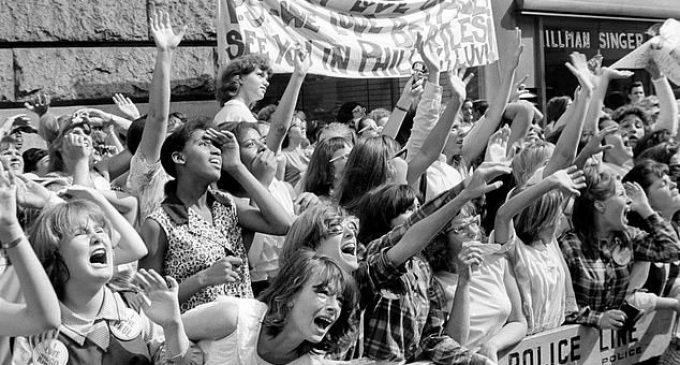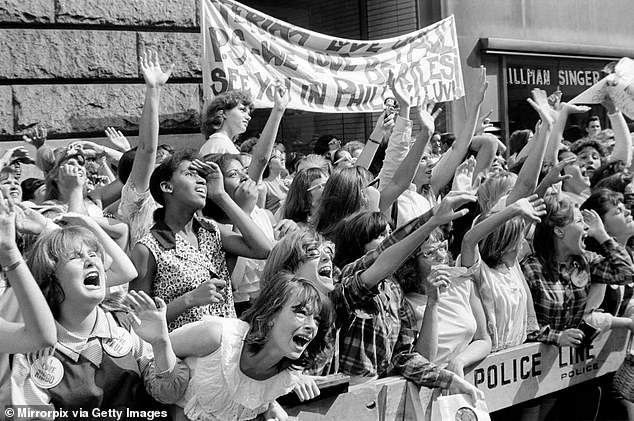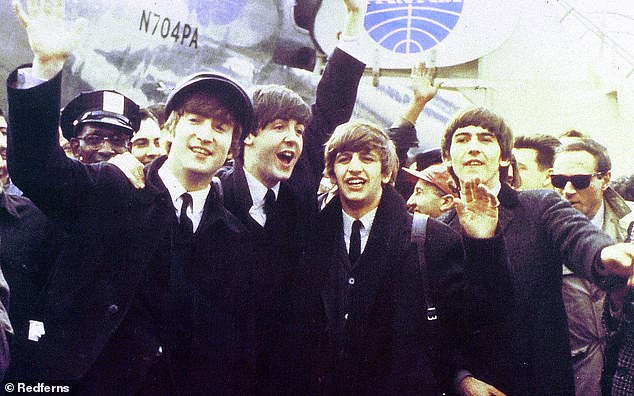How America fell for the Fab Four: The Beatles arrived in the U.S. like a tidal wave | Daily Mail Online

One day in mid-October 1963, John Lennon had dropped by at the house in Wimpole Street, London, where Paul was living with the family of his girlfriend, Jane Asher.
The two of them went down to a little room in the basement and sat together on Mrs Asher’s piano stool.
Their manager Brian Epstein had told them that their next, most important task was to compose a song to crack the elusive American market.
Up to now, their hit singles in Britain — From Me To You, She Loves You, Please Please Me — had all flopped over there.
After an hour or so of doodling about, Paul went upstairs to the bedroom of Jane’s brother, and put his head around the door.
‘Do you want to come and hear something we’ve just written?’ he asked. Peter Asher accompanied him back downstairs, and together Paul and John played him their new song, I Want To Hold Your Hand.
‘What do you think?’ asked Paul. ‘Oh, my God! Can you play that again?’ said Peter. As he listened to it for a second time, he thought: ‘Am I losing my mind, or is this the greatest song I ever heard in my life?’
It was released in America as a single on Boxing Day 1963. At three in the morning on January 17, 1964, the Beatles were relaxing in a hotel suite in their pyjamas and dressing gowns when their manager Brian Epstein came in, clutching a telegram.
‘Boys,’ he said, ‘you’re No 1 in America!’ For once, even John was thrilled. Ringo was cock-a-hoop: ‘We couldn’t believe it. We all started acting like people from Texas, hollering and shouting ya-hoo.’
The others picked Ringo up and — ‘One, two, three, four!’ — threw him into the air. In the first three days of its U.S. release: I Want To Hold Your Hand sold a quarter of a million copies. It went on to sell five million.
When Brian Wilson, of the Beach Boys, heard it: ‘I flipped. It was like a shock went through my system.’
In that instant, Wilson realised that the Beatles had rendered him antique. He was two days younger than Paul, but now felt like an old-timer: ‘I immediately knew that everything had changed.’
For the past six months the Beach Boys had been the most popular group in America. But from now on they would be obliged to live in the shadow of the Beatles.
In Freehold, New Jersey, a 14-year-old boy was sitting in the front seat of his mother’s car when the song came on the radio. He felt time stop, and his hair standing on end.
They reached home, but he didn’t go in. Instead, he ran straight to the bowling alley on Main Street, rushed to the phone booth and called his girlfriend Jan. ‘Have you heard the Beatles?’ he asked.
‘Yeah, they’re cool,’ she replied. He instantly set his heart on a guitar displayed in the window of the West Auto store on Main Street.
When the summer came, his Aunt Dora paid him to paint her house, and he bought the guitar with the money he earned. He lived for every release by the Beatles: ‘I searched the newsstands for every magazine with a photo I hadn’t seen and I dreamed . . .dreamed. . .dreamed . . . that it was me. I didn’t want to meet the Beatles. I wanted to be the Beatles.’
Over half a century on, Bruce Springsteen still believes that hearing I Want To Hold Your Hand that day in his mother’s car changed the course of his life.
The Beatles arrived in America with the sudden impact of a tidal wave. By the time their plane touched down in New York, orders for merchandise were rolling in: half a ton of Beatles wigs were following them to America, plus 24,000 rolls of Beatles wallpaper.
As the plane door opened, screams from fans drowned out the sound of the jet engines.
The 13-year-old Tom Petty watched their appearance on The Ed Sullivan show on the family television in Gainesville, Florida.
‘There is a way out,’ he thought. ‘You get your friends and you’re a self-contained unit. And you make the music.’
Within weeks, groups were playing in garages all over his neighbourhood. Billy Joel, 14, was watching with his family on Long Island: ‘They looked like these working-class kids, like kids we all knew.’
He knew his destiny then and there: ‘I said at that moment: ‘I want to be like those guys. This is what I’m going to do — play in a rock band.’ ‘
Not everyone was quite so enthralled. George Dixon in the Washington Post noted: ‘They have a commonplace, rather dull act that hardly seems to merit mentioning.’
In the National Review, the conservative iconoclast William F. Buckley penned a diatribe under the title: ‘Yeah, Yeah, Yeah, They Stink.’
The viewing figures offered no comfort to the critics. Seventy three million Americans had tuned in to The Ed Sullivan Show, the second-largest viewing figure in the history of commercial television.
The first came 11 weeks earlier, following the chilling words ‘News just in of shots fired in Dallas.’
Pam Miller, 16, of Reseda, California, was so besotted with the new arrivals that within the privacy of her schoolgirl diary she turned herself into a Liverpudlian.
On February, 10, 1964, she wrote: ‘Paul you are gear. Really Fab. Say chum, why are you so marvellous, luv? The most bloomin’ idiot on earth is me, cause I’m wild over you chap.’
From then on she posted Paul a poem every day, sealed with a kiss. Virtually every day, her local radio station would deliver an update on the state of Paul’s relationship with his new girlfriend.
Pam listened with growing resentment of the young lady she came to call ‘the creepy freckle-faced bow-wow, Jane Asher’, or simply ‘Pig-Face’.
Maxine M., in Cleveland, Ohio, wrote asking the Beatles to call her, adding: ‘If my mother answers, hang up. She is not much of a Beatle fan.’
Donna J., from Portland, Maine, admitted in her letter: ‘I have every one of your records and I don’t even have a record player.’
Touching down in Houston the following year, the Beatles’ plane was surrounded by fans while its engines were still running.
Some managed to climb onto the wings, and crawled towards the portholes, waving at those inside. In Dallas, young fans walked from the airport to the Beatles’ hotel, many of them in tears.
One clutched a bunch of grass in her hands, screaming: ‘Ringo! Ringo walked on this grass!’
By April 4, 1964, The Billboard Hot 100 went like this:
1. Can’t Buy Me Love — The Beatles.
2. Twist and Shout — The Beatles.
3. She Loves You — The Beatles.
4. I Want to Hold Your Hand — The Beatles.
5. Please Please Me — The Beatles
Also:
31. I Saw Her Standing There — The Beatles.
41. From Me To You — The Beatles.
46. Do You Want to Know a Secret — The Beatles.
58. All My Loving — The Beatles.
65. You Can’t Do That — The Beatles.
68. Roll Over Beethoven — The Beatles.
79. Thank You Girl — The Beatles.
In addition, two songs about the Beatles made the Hot 100 that week: We Love You Beatles by the Carefrees, and A Letter To The Beatles by the Four Preps.





There are no comments at the moment, do you want to add one?
Write a comment